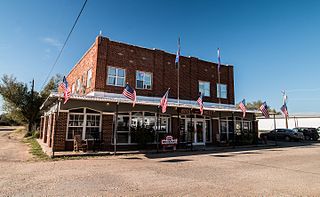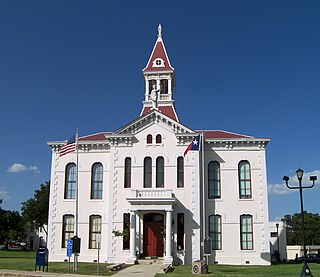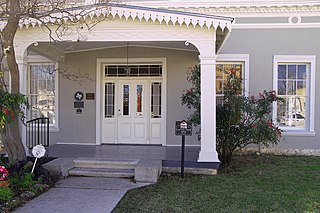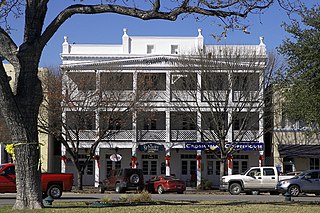
The Adolphus Hotel is a historic upscale hotel established in 1912 in the Main Street District of Downtown Dallas, Texas. A Dallas Landmark, it was for several years the tallest building in the state. Today, the hotel is part of Marriott's Autograph Collection brand.

The Magnolia Hotel is a 29-story, Beaux-Arts style, upscale hotel in the Main Street District of downtown Dallas, Texas, that for many years was the tallest building in the state after surpassing the Adolphus Hotel. The structure is a Dallas Landmark and is listed on the National Register of Historic Places.

The Kirby Building, historically known as the Busch Building, is a 17-story skyscraper in the Main Street District of Downtown Dallas. The structure was completed in 1913 by beer magnate Adolphus Busch to accompany his nearby Hotel Adolphus. The building became vacant with many older buildings during the economic downturn of the 1980s. While the building was symbolic of downtown's crash in the 1980s, it also served as a symbol of the start of the resurrection as it became the first high-rise to be converted from office use to residential apartments. The structure is a Dallas Landmark and listed on the National Register of Historic Places.

The Caldwell County Courthouse is a historic courthouse located in Lockhart, Texas, United States. The courthouse was built in 1894 to replace the existing courthouse, which was too small for the growing county. The courthouse was designated a Recorded Texas Historic Landmark in 1976 and was listed on the National Register of Historic Places as a contributing property of the Caldwell County Courthouse Historic District on January 3, 1978.

The Caldwell County Courthouse Historic District is a historic district located in Lockhart, Texas, the seat of Caldwell County. The historic district encompasses 67 buildings on 250 acres (1.0 km2) across downtown Lockhart. One building included in the historic district, the Emmanuel Episcopal Church, was previously listed on the National Register of Historic Places in 1974. The historic district was added to the National Register of Historic Places on January 3, 1978.

This is a list of the National Register of Historic Places listings in Tarrant County, Texas.

Fanthorp Inn State Historic Site is a historic hotel in Anderson, Texas. The Texas Parks and Wildlife Department acquired the 6-acre (2.4 ha) site by purchase in 1977 from a Fanthorp descendant. Ten years were spent researching and restoring the Inn to its 1850 look. The site was opened to the public on October 4, 1987.

The Hotel Turkey is a historic hotel located in Turkey, Texas, United States that originally opened in 1927. The building was added to the National Register of Historic Places on October 24, 1991.

The Bandera County Courthouse and Jail are two separate historic county governmental buildings located near each other in Bandera, Bandera County, Texas, The Bandera County Courthouse, built in 1890 at the corner of Main and Pecan streets, is a Renaissance Revival style building designed by San Antonio architect B. F. Trester. It is three-story building with a central clock tower made from rusticated limestone cut from a local quarry. The clock is non-functioning and painted on, displaying the time 10:09. The current jail is a non-historic, modern facility located along State Highway 16 on the north end of town.

The Wilson County Courthouse and Jail are located in Floresville, Texas. They were added to the National Register of Historic Places in Texas in 1978 and the courthouse as a Recorded Texas Historic Landmark in 1984.

The Pioneer Memorial Library is located at 115 W. Main Street, Fredericksburg, Gillespie County, in the U.S. state of Texas. Designed by Alfred Giles, it was built in 1882 to replace the original 1855 courthouse, and was later superseded by the current 1939 courthouse designed by Edward Stein. The first floor houses the Children's Section, while the second floor houses the Adult Section, Texas Room, and newspapers and magazines. It is also called the McDermott Building because of the 1967 and 1984 restorations funded by Mr. & Mrs. Eugene McDermott. It was added to the National Register of Historic Places in 1971, and was designated a Recorded Texas Historic Landmark in 1967.

The Presidio County Courthouse is located in Marfa, Presidio County in the U.S. state of Texas. It was added to the National Register of Historic Places in 1977. It was designated a Recorded Texas Historic Landmark in 1964.

Alfred Giles was a British architect who emigrated to the United States in 1873 at the age of 20. Many of the private homes and public buildings designed by Giles are on the National Register of Historic Places and have been designated Recorded Texas Historic Landmarks. Based in San Antonio, his buildings can be found predominantly in south Texas and northern Mexico. Giles is credited with "a profound influence on architecture in San Antonio."

The Carl Wilhelm August Groos House is located in the Bexar County city of San Antonio in the U.S. state of Texas. It was designated a Recorded Texas Historic Landmark in 1977. Designed by Alfred Giles in 1880, the building contractor was John H. Kampmann. Giles used a Victorian Gothic Revival on this limestone home. Groos had immigrated from Germany to Texas in 1848, at which time he and his brothers started a freighting firm. In 1871, he built the Carl W. A. Groos House in New Braunfels. In 1872, he and his family settled in San Antonio. Groos married Hulda Amalie Moureau and became a founding member of the Groos National Bank. In 1880, Groos hired Giles to build his San Antonio home. It is listed on the National Register of Historic Places listings in Bexar County, Texas as a contributing structure of the King William Historic District. Groos died in 1893. In 1957, the house was purchased by the San Antonio Council of the Girl Scouts of the USA. The Girl Scouts sold the home to Charles Butt. It has been restored and is in private ownership.

This is a list of the National Register of Historic Places listings in Comal County, Texas.

The Carl W. A. Groos House is located in the city of New Braunfels, county of Comal, in the U.S. state of Texas. It was added to the National Register of Historic Places listings in Comal County, Texas in 2000, and designated a Recorded Texas Historic Landmark in 1968. Groos occupied this house for approximately one year. He moved to San Antonio, and in 1880 had architect Alfred Giles design his home which became known as the Carl Wilhelm August Groos House. Originally owned by one of the early German emigrants to New Braunfels, the house has also remained in the hands of descendants of the early German settlers. Diplomat Bob Krueger used the building for his business office and renovated it in 1999.

The Edward Steves Homestead is located in the Bexar County city of San Antonio in the U.S. state of Texas. It was designed by architect Alfred Giles and designated a Recorded Texas Historic Landmark. The main house was donated to the San Antonio Conservation Society in 1952. The organization completely restored the main house as a museum, and now conducts daily tours. The complete homestead property consists of four individual structures: the main house museum, the carriage house, the river house, and the servants' quarters. It is listed on the National Register of Historic Places listings in Bexar County, Texas, as a contributing structure of the King William Historic District.

Acequia Madre de Valero is an 18th-century agricultural irrigation canal built by the Spanish and located in the Bexar County city of San Antonio in the U.S. state of Texas. When Martín de Alarcón founded San Antonio for Spain by establishing San Antonio de Valero Mission in 1718, Franciscan priest Antonio de Olivares and the Payaya and Pastia peoples, dug Acequia Madre de Valero by hand. It was vital to the missions to be able to divert and control water from the San Antonio River, in order to grow crops and to supply water to the people in the area. This particular acequia was the beginning of a much wider irrigation system. Acequia Madre de Valero ran from the area currently known as Brackenridge Park southward to what is now Hemisfair and South Alamo Street. Part of it that is not viewable by the public runs beneath the Menger Hotel. The acequia was restored in 1968 and that same year was designated a Recorded Texas Historic Landmark.

This is a list of the National Register of Historic Places listings in Garza County, Texas.

The Guadalupe Hotel is a historic hotel in downtown New Braunfels, Texas. It is located on the Main Plaza, adjacent from the Comal County Courthouse.
























